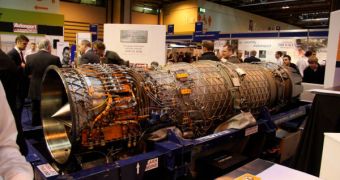This is one of those instances in which the word “car” is being used in its loosest form. The only connections between the Bloodhound SSC and your average minivan is that they both have four wheels and a body. But the similarities stop here, and the differences begin. Built specifically to beat the existing land speed record, the UK machine is in fact nothing more than a rocket bolted to a Eurofighter-Typhoon jet engine, which employs aerobrakes, parachutes and carbon brakes to help it stop. The BBC News takes us behind the scenes with Royal Air Force fighter pilot Andy Green.
The mechanical monster is designed to reach no less than 1,000 miles per hour (1,609 kilometers/hour), using a jet engine that is pretty remarkable in size. In addition to breaking the existing record by a large difference, the Bloodhound is also meant to incite some more interest in science and technology on part of the British people. “If we want to live in a high technology low-carbon world in the near future, then someone is going to have to build it for us, and that someone needs to be inspired now,” Green said.
He also added recently that the construction phase of the machine was going very well, but that the team was at the moment still trying to decide between using symmetrical or asymmetrical wheel designs. “The proposed symmetrical wheel may prove to be stronger, lighter and cheaper – which are all good things when there are incredible G-forces at the wheel rim,” Green explained. “This month we've also agreed a range of 'down' loadings, or downloads, for the wheels (never less than static weight on each wheel, and never more than a 2:1 ratio of weight distribution between the front and rear wheels).”
Another great challenge facing the construction team is deciding on the optimum wheel, suspension, fin and bodywork layout combination, to ensure that, at the very least, the car remains on the ground, and does not take off. While this may seem ridiculous to some, it is a very thorny issue for machines running at these speeds. Any bumps in the road could send it nose-up several hundred feet in the air, and it most certainly cannot fly.
And this brings us to another challenge, namely finding the right desert to test the Bloodhound SSC. “Following recent tests, we've found out that surface preparation can be done adequately in South Africa, but not so easily in the US,” Green said. The team also has to decide on a location to build the machine at, with four cities competing to attract the project. “We're about to find out, with the four cities bidding to host us, and the bid proposals now coming in, we'll soon know. These are exciting times,” the test pilot concluded.

 14 DAY TRIAL //
14 DAY TRIAL //